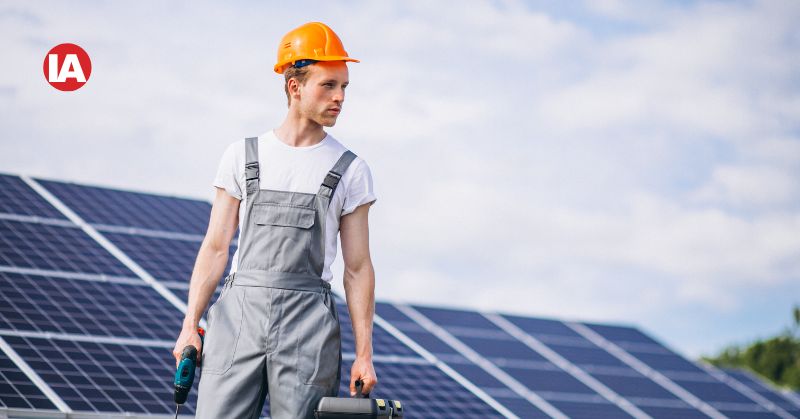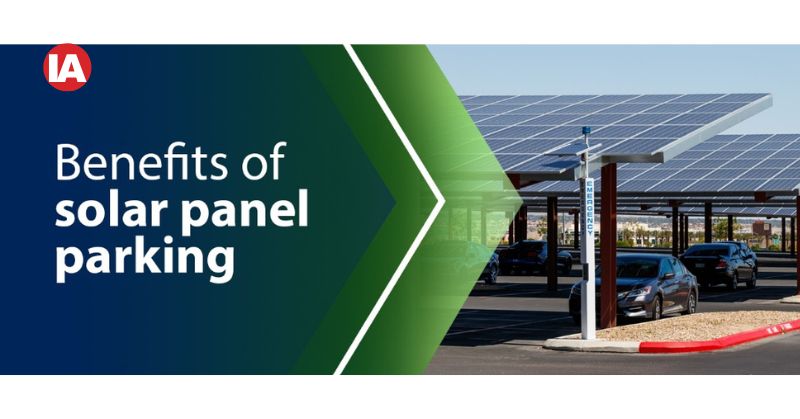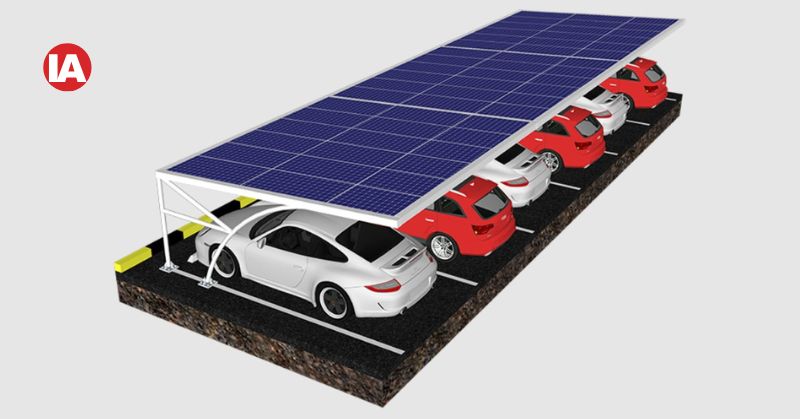Solar Canopies: Transforming Parking Lots for EV Charging
Explore how solar canopies transform parking lots into sustainable EV charging facilities, utilizing otherwise unused space for renewable energy generation.
![[object Object]](https://admin.industrialautomationindia.in/storage/articles/article-SARa3YE4bfrJsB2i7tr5V9FlF1pNtqWqhCm13a5I.jpg)
By utilising otherwise wasted space, solar canopies are transforming the parking lots into EV charging facilities, says Jasbir Singh.

Image by senivpetro on Freepik
As awareness of climate change grows, the shift toward renewable energy is gaining momentum. The future of solar technology is promising. The world is on the lookout for sustainable energy solutions, and one exciting development in this area is the solar panel canopy. Solar-powered parking solutions offer numerous benefits, including environmental sustainability and cost-effectiveness, while generating clean energy for various uses. These innovative structures offer a unique way to incorporate renewable energy into everyday public spaces, such as parking lots. By utilising otherwise wasted space, solar canopies efficiently capture sunlight to produce electricity. Increasingly popular among businesses and public facilities, solar canopies provide a practical means to harness solar power for charging vehicles. As more people recognise the advantages they offer, interest is growing in how these canopies will redefine the future of parking lots.
The financial and environmental advantages of solar energy have reached new heights. Companies looking to take advantage can now install solar canopies over their parking lots, unlocking substantial savings. Across the country, businesses are turning their parking spaces into solar power sources, offering shade for vehicles while generating renewable energy, and saving thousands of rupees on their electricity bills in the process.
Benefits of going solar
1. Generates consistent, eco-friendly and reliable energy: Solar panels are an excellent way to embrace green energy. They are reliable, easy to install, and require minimal maintenance. As long as there’s sunlight, solar panels produce electricity, shielding you from the high energy prices.
2. Enhances energy independence facility: Solar power allows parking lots to become less reliant on the electric grid, reducing energy costs and enhancing resilience against power outages.
3. Lowers costs of energy: Integrating a solar car park into your facility can provide free, clean electricity, significantly lowering your energy expenses. More parking bays mean greater savings on energy costs while also minimising your carbon footprint.
4. Generate additional revenue streams: In addition to saving on power bills, large parking facilities can sell surplus electricity back to the grid or use at residence.
5. Improves safety and security: Solar-powered parking systems boost safety and security. These self-sufficient systems don’t rely on external power sources, ensuring continuous operation even during outages, giving users peace of mind that his vehicles are protected.
6. Enhances asset value: Investing in solar panels can enhance the long-term value of its parking facility by making it more efficient, attractive, and sustainable.
Key advantages of solar canopies for parking
- Substantial energy savings
- Reduced maintenance costs for parking lots
- Decreased carbon footprint
- Effective use of available space
- Easy integration of EV chargers, and
- Investing in solar car parks isn’t just a smart choice; it’s a step toward a more sustainable future.

Why go solar? The benefits of a solar car park
Solar energy is the cleanest and most sustainable energy source available. While the specifics of energy production and financial returns vary by installation, solar panels typically have a lifespan of 25 to 30 years before needing replacement. With ongoing advancements in technology, newer solar panels are more efficient and take up less space. Solar energy for parking facilities is becoming more feasible than ever.
The solar-powered, digitally controlled parking bay system offers an effective solution for managing both individual and multiple parking spots in residential and commercial areas. It's also an ideal choice for locations with limited access to the electrical grid, as it operates independently without needing an additional power source in day time. Even in lots with reliable grid access, solar energy ensures that the system remains operational during power outages. These can be constructed from a highly durable material. These systems are built to withstand various weather conditions. They're efficient, reliable, and easy to install and require no digging for foundations. Instead, the unit is simply bolted to the road surface.
One of the standouts features available is the ability to control the system digitally through a smartphone app. Users can easily start charging by downloading the app on their phone, tablet, or computer. Additionally, the system allows for digital key sharing, enabling multiple users to access a single parking spot at their designated times without the hassle of physical keys.
Installing solar panels over parking lots serves a dual purpose.
Solar carport structures not only harness the sun's energy to reduce costs but also demonstrate your commitment to sustainability. This creates a win-win for aiming to lower energy expenses while enhancing comfort for users for parking under shaded areas.
Typically, these structures are constructed from GI steel or aluminium and equipped with solar panels. These carports can be connected to existing poles or buildings for added stability. The typical return on investment (RoI) ranges from 4 to 6 years, allowing users to enjoy free solar energy for decades afterward. These structures are ideal for commercial areas, but they can also add value to residential properties, helping homeowners save on utility bills over time for excess generated electricity through installed solar panels for other purposes.
As electric vehicles (EVs) become more popular, the need for charging points/stations grows. By integrating solar carports with EV charging solutions, we can create a sustainable facility.

Contactless EV vehicle charging
The contactless EV charging system represents a significant advancement in effortless vehicle charging. This innovative technology utilises a floor pad that emits a magnetic field, allowing parked electric vehicles (EVs) to charge wirelessly. It can be implemented in public parking areas and garages, providing a convenient solution for EV owners. WiTricity, having acquired Qualcomm’s contactless charging technology, emphasizes that this system is compatible with any EV model or platform. The floor-mounted electromagnets generate electromagnetic waves that are absorbed by the vehicle’s engine and transmitted to the battery for charging. Importantly, there is no efficiency loss when compared to traditional wired charging methods. The concept of inductive charging is quite simple: an electric vehicle is equipped with a specialised charging coil that aligns with a charging coil embedded in the ground. Once positioned correctly, the charging process begins automatically, eliminating the need for cables. Qualcomm also possesses the ‘Halo’ technology, developed in collaboration with the University of Auckland, which enhances this experience by enabling dynamic electric vehicle charging (DEV C). This system allows electric cars to charge while in motion, using a combination of vehicle-mounted ‘Halo’ sensors and road-embedded wireless charging infrastructure.
Solar canopy provides shade from sun and protect from rain
If we ever entered a car that’s been sitting/exposed to the sun all day, we know just how uncomfortable it is to get in. That’s why the shade from a solar canopy is such a valuable feature. But the benefits extend beyond just comfort; it can also boost the fuel efficiency of vehicles parked underneath. Air conditioning is the main reason for reduced fuel economy in hot weather. When a car has been baking in the sun, using the AC can lower fuel efficiency by more than 25 percent for conventional vehicles, with even greater effects for hybrids and plug-in hybrids.
Solar powered automatic gate system
Solar-powered automatic gate systems operate independently off the grid, giving you control over property access. These systems are perfect for both commercial properties and residential areas. By utilising solar energy, they offer an eco-friendlier alternative to traditional battery-powered gates.
With a solar-powered gate barrier, you can ensure your property remains secure and accessible, even during power outages. This feature is especially valuable for commercial properties that require 24/7 operation, providing a reliable and efficient access control solution.
Attributes to financial viability and return on investment
The financial viability of solar canopy will largely depend on the system's size and the current electricity expenses. Here are some key points to consider:
1. Solar panels generally produce their peak output in the afternoon, coinciding with high demand charges. If your business faces these charges during peak times, a solar canopy can significantly lower your electricity bills by reducing grid consumption when rates are highest.
2. While a solar parking lot typically costs little more than a comparable rooftop installation due to the extra labour and materials required for the canopies, it also offers notable advantages.
3. Rooftop solar arrays depend on the roof's characteristics. If your roof doesn’t face south, has an unsuitable pitch, or features obstructions like exit room for staircase coverage, skylights, or vents, the solar array's efficiency can be compromised. In contrast, a parking canopy allows us to position the panels for optimal electricity production, maximising both energy output and savings.
Installing a solar canopy over an existing parking lot optimises space more effectively than a traditional ground-mounted system. By adding a solar canopy, people enhance the functionality of the same area without needing extra land. Sometimes the vertical solar panels installation provides an innovative solution for maximising limited urban spaces while meeting the increasing demand for renewable energy. By taking advantage of vertical space in parking lots, these panels can be installed without sacrificing parking capacity or requiring complex carport structures. The benefits of vertical solar panels include a cutting-edge design for parking areas, the potential for additional income or reduced utility costs, and increased property value.
Conclusion

Solar canopies are elevated structures designed to support solar panels while offering shade. They are often installed over parking lots or paved areas, functioning as solar carports and ground-mounted solar systems. These canopies are a great alternative to rooftop solar, particularly when roofs are unsuitable for installation or when a business's energy needs exceed what a rooftop system can provide. Furthermore, solar canopies make it easy to install electric vehicle charging stations, accommodating all types of EVs.
Jasbir Singh is an Automation Expert having long experience in Factory Automation, Line Automation, Implementation Strategist, Business Coach, Regular writer on automation, Artificial Intelligence, Robots/Cobots, Digital Technology, Network Communication, Industrial Internet of Things (IIoT), Wireless Communication, Block Chain and use of advance digital technologies. He has established a long association with Business Houses/large production houses to improve factory automation in their production lines as well as productivity improvement in factories in India and overseas; and in advising and designing the units to transform into digital platforms by use of Artificial Intelligence. Email: marketing@seeglobalinternational.com
______________________________________________________________________________________________
For a deeper dive into the dynamic world of Industrial Automation and Robotic Process Automation (RPA), explore our comprehensive collection of articles and news covering cutting-edge technologies, robotics, PLC programming, SCADA systems, and the latest advancements in the Industrial Automation realm. Uncover valuable insights and stay abreast of industry trends by delving into the rest of our articles on Industrial Automation and RPA at www.industrialautomationindia.in
